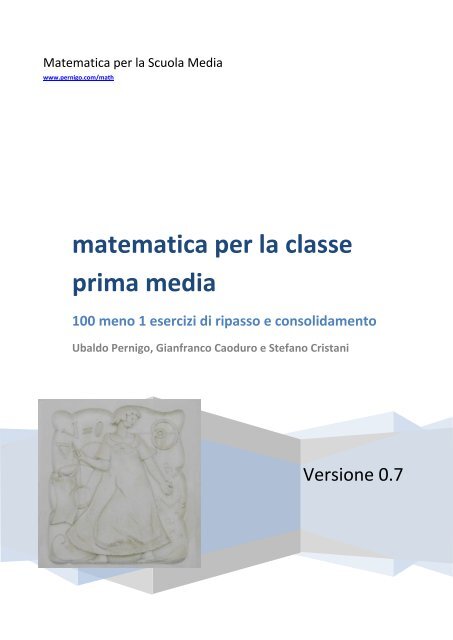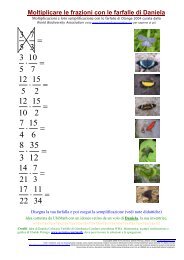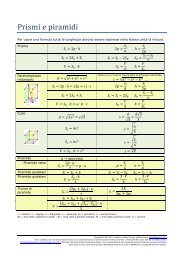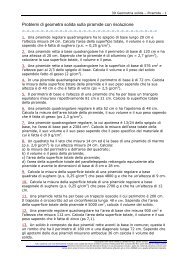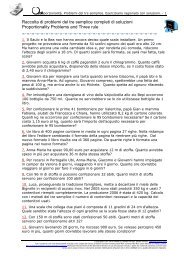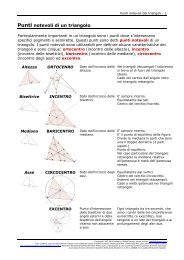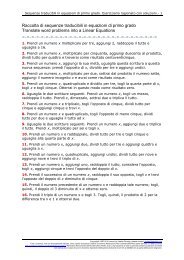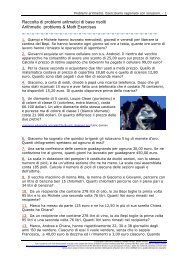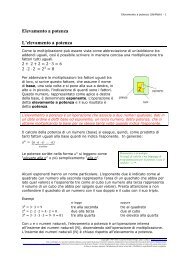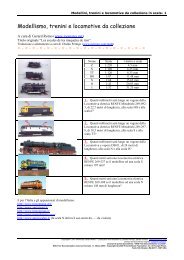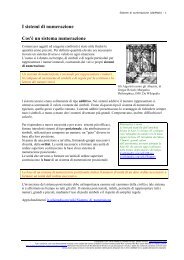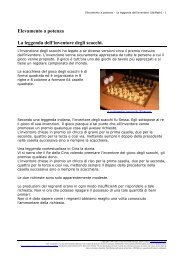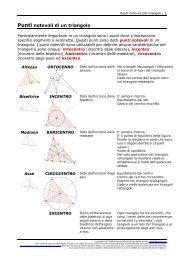matematica per la classe prima media - UbiMath
matematica per la classe prima media - UbiMath
matematica per la classe prima media - UbiMath
You also want an ePaper? Increase the reach of your titles
YUMPU automatically turns print PDFs into web optimized ePapers that Google loves.
Matematica <strong>per</strong> <strong>la</strong> Scuo<strong>la</strong> Media<br />
www.<strong>per</strong>nigo.com/math<br />
<strong>matematica</strong> <strong>per</strong> <strong>la</strong> c<strong>la</strong>sse<br />
<strong>prima</strong> <strong>media</strong><br />
100 meno 1 esercizi di ripasso e consolidamento<br />
Ubaldo Pernigo, Gianfranco Caoduro e Stefano Cristani<br />
Versione 0.7
INTRODUZIONE<br />
Eserciziario di ripasso e consolidamento <strong>per</strong> <strong>la</strong> c<strong>la</strong>sse <strong>prima</strong> <strong>media</strong>.<br />
Sono disponibili ulteriori esercizi, di completamento al presente <strong>la</strong>voro e tutti risolti in<br />
modo guidato e commentati, ed è possibile esercitarsi e giocare direttamente in linea<br />
con <strong>la</strong> <strong>matematica</strong> su www.<strong>per</strong>nigo.com/math<br />
LICENZA<br />
Attribuzione-Non o<strong>per</strong>e derivate 2.5 Italia<br />
Tu sei libero di riprodurre, distribuire, comunicare al pubblico, esporre in pubblico,<br />
rappresentare, eseguire e recitare quest'o<strong>per</strong>a.<br />
Alle seguenti condizioni:<br />
� Attribuzione. Devi attribuire <strong>la</strong> paternità dell'o<strong>per</strong>a nei modi indicati dall'autore o da chi ti ha<br />
dato l'o<strong>per</strong>a in licenza e in modo tale da non suggerire che essi avallino te o il modo in cui tu usi<br />
l'o<strong>per</strong>a.<br />
� Non o<strong>per</strong>e derivate. Non puoi alterare o trasformare quest'o<strong>per</strong>a, ne' usar<strong>la</strong> <strong>per</strong> crearne un'altra.<br />
� Ogni volta che usi o distribuisci quest'o<strong>per</strong>a, devi farlo secondo i termini di questa licenza, che va<br />
comunicata con chiarezza.<br />
� In ogni caso, puoi concordare col tito<strong>la</strong>re dei diritti utilizzi di quest'o<strong>per</strong>a non consentiti da questa<br />
licenza.<br />
� Questa licenza <strong>la</strong>scia impregiudicati i diritti morali.<br />
Le utilizzazioni consentite dal<strong>la</strong> legge sul diritto d'autore e gli altri diritti non sono in alcun<br />
modo limitati da quanto sopra.<br />
Questo è un riassunto in linguaggio accessibile a tutti del Codice Legale (<strong>la</strong> licenza integrale):<br />
http://creativecommons.org/licenses/by-nd/2.5/it/legalcode .<br />
Sommario<br />
INTRODUZIONE .................................................................................................................................................. 2<br />
LICENZA.............................................................................................................................................................. 2<br />
ARITMETICA ....................................................................................................................................................... 3<br />
Espressioni ......................................................................................................................................................... 3<br />
Problemi aritmetici ............................................................................................................................................ 4<br />
Divisibilità .......................................................................................................................................................... 5<br />
Problemi di massimo e minimo ......................................................................................................................... 5<br />
Frazioni .............................................................................................................................................................. 6<br />
Problemi con le frazioni ..................................................................................................................................... 7<br />
GEOMETRIA PIANA ............................................................................................................................................ 7<br />
Elementi di geometria .................................................................................................................................... 7<br />
Angoli e calcolo con i numeri complessi ........................................................................................................ 8<br />
Triangoli ......................................................................................................................................................... 9<br />
Quadri<strong>la</strong>teri .................................................................................................................................................... 9<br />
Piano cartesiano ............................................................................................................................................. 9<br />
<strong>UbiMath</strong>i # <strong>per</strong> <strong>la</strong> c<strong>la</strong>sse <strong>prima</strong> <strong>media</strong><br />
2
ARITMETICA<br />
=-=-=-=-=-=-=-=-=-=-=-=-=-=-=-=-=-=-=-=-=-=-=-=-=-=-=-=-=<br />
Espressioni<br />
1.<br />
17 + [13 + (2 + 8) + (21 - 9)] [52]<br />
2.<br />
3.<br />
4.<br />
5.<br />
6.<br />
7.<br />
8.<br />
9.<br />
10.<br />
11.<br />
12.<br />
(10 - 2) – [(15 + 12 - 17) – (26 + 10 + 5 - 33)] [6]<br />
35 - 10 + 5 - [35 - (5+ 10 - 5)] - 1= [4]<br />
6 : 2 + 8 · 4 – (3 + 2 + 1) · 5 = [ ]<br />
(10 + 1 + 5) : 8 + (80 + 40) : 60 = [ ]<br />
(34 : 2 + 3 · 3 – 5 · 2 · 2) : 6 - 1 = [ ]<br />
(7 + 4 + 3) – (8 + 2) + (11 + 6) : 17 = [ ]<br />
18 · 6 � 27 - [26 - (81 � 9 · 2 � 3 + 3 · 6)] = [ ]<br />
[12 + 3 – 11 – 3 + (18 + 7 – 5 + 3 - 9) : 7] + 10 – 2 - 8 = [ ]<br />
51 � {12 + 3 · [2 · 18 – 9 · (24 � 6 - 2) � 6] - 60} + 7 = [ ]<br />
[2,5 · 0,8 + (2,3 + 2,7) · (2,5 · 2)] · 2 – (1,8 · 10) · (7,5 · 0,4) = [0]<br />
[6 – (1,5+3,5) · 0 + (1,5·2) · (0,9+2,1) – 0,2:0,2] · 2 – 6:0,5 = [16]<br />
=-=-=-=-=-=-=-=-=-=-=-=-=-=-=-=-=-=-=-=-=-=-=-=-=-=-=-=-=<br />
13.<br />
14.<br />
15.<br />
16.<br />
2 3 + 5 2 – 4 2 + 2 2 - 20 : 2 – 5 0 = [ ]<br />
3 3 : 9 + 2 4 : 4 – 3 · 1 5 = [ ]<br />
0 5 : 9 + 4 2 + 3 3 - 5 2 - 2 2 · 2 = [ ]<br />
{[(2 6 · 2 4 : 2 8 ) : 2 2 + 1] 3 : 2 2 } 0 = [ ]<br />
=-=-=-=-=-=-=-=-=-=-=-=-=-=-=-=-=-=-=-=-=-=-=-=-=-=-=-=-=<br />
17.<br />
18.<br />
(2 2 ) 3 + (22 – 5 · 4) 2 + 9 2 - 4 2 · 5 = [ ]<br />
[(3 4 ) 3 :3 10 ] 5 : 3 9 +(5 4 ) 3 :5 10 -2 2 ·7 1 = [ ]<br />
<strong>UbiMath</strong>i # <strong>per</strong> <strong>la</strong> c<strong>la</strong>sse <strong>prima</strong> <strong>media</strong><br />
3
19.<br />
20.<br />
21.<br />
22.<br />
23.<br />
(3 5 ) 3 :3 13 +3 10 :3 9 +9 5 · 9 7 · 9 4 : 9 16 = [ ]<br />
[(7 4 · 2 4 · 9 4 ) : (7 2 · 2 2 · 9 2 )� 4 : (504 8 : 4 8 ) = [ ]<br />
3 3 · 3 7 · 3 2 : (3 6 · 3 6 ) + 5 2 - [6 2 + 2 2 + 2 · 50 - (2 3 · 5)] : 10 2 = [ ]<br />
(13·3 3 – 2 6 · 5) 2 : 31 - [(6-5) 6 + (2 2 +3 2 -2 1 )] : (2 4 : 2 2 ) = [ ]<br />
(2·5) 3 : 5 3 - (2 3 : 2 2 ) · {(6 – 2 2 ) · [6 – 5 0 - (2 4 : 2 2 )]} = [ ]<br />
=-=-=-=-=-=-=-=-=-=-=-=-=-=-=-=-=-=-=-=-=-=-=-=-=-=-=-=-=<br />
Problemi aritmetici<br />
24. Giacomo ha sognato che quindici briganti gli rubavano 5 kg di monete d’oro.<br />
Quanti chilogrammi spettano a ognuno di essi? [stanno ancora litigando xchè…]<br />
25. Una sarta confeziona delle camicie guadagnando <strong>per</strong> ognuna 30,00 euro. Se ne<br />
confeziona tre al giorno, quanti giorni ha <strong>la</strong>vorato <strong>per</strong> guadagnare 450,00 euro. [3]<br />
26. La sca<strong>la</strong> in dotazione dei pompieri è costituita da 12 pezzi, tutti formati dallo<br />
stesso numero di pioli tranne l’ultimo che ne ha meno. Sapendo che <strong>la</strong> sca<strong>la</strong> è<br />
costituita da 185 pioli, calco<strong>la</strong> il numero di pioli di ciascun pezzo di sca<strong>la</strong>. [15; 5]<br />
27. Il vecchio macinino di nonna Rita, <strong>la</strong> nonna di Giacomo e Giovanni, <strong>per</strong>corre con<br />
un litro di benzina ben 15 chilometri. Quanti chilometri <strong>per</strong>corre con il pieno pari a 34<br />
litri di benzina? [510]<br />
28. Da un recipiente che contiene 278 litri di olio, lo zio Bepi toglie <strong>la</strong> <strong>prima</strong> volta 95<br />
litri e lo zio Michele 76 litri. Quanti litri sono rimasti nel recipiente? [107]<br />
29. Marco ha messo da parte 125 euro e ne ha 12,50 in più di sua sorel<strong>la</strong> Chiara.<br />
Quanto ha Chiara? [112,50]<br />
30. Marco, Andrea e Chiara, hanno rispettivamente 22, 30 e 38 giornalini degli anni<br />
’60 da vendere. Ciascuno li vuole vendere, senza che lo sappia Francesca, a 40,00<br />
euro <strong>la</strong> dozzina e i rimanenti a 3,00 euro ciascuno. Quando Marco, Andrea e Chiara<br />
hanno venduto tutti i loro giornalini, quanto ha ricavato ognuno di essi? [70; 98; 126]<br />
31. Giacomo e Giovanni hanno insieme 120 euro. Il gemello più vecchio, Giovanni, ha<br />
il triplo dell’altro. Trova quanto ha ciascuno dei due gemelli. [90; 30]<br />
32. Un carto<strong>la</strong>io acquista 15 scatole contenenti 12 penne ciascuna pagando ogni<br />
matita 0,55 euro. Acquista, inoltre, 24 quaderni al prezzo unitario di 0,80 euro. La<br />
merce venduta. Le penne vengono esposte con un prezzo di 0,80 euro l’una e i<br />
quaderni a 1,15 euro cadauno. Quale guadagno realizzerà il carto<strong>la</strong>io? [53,40]<br />
33. Lo zio Bepi vende 420 uova a 50 centesimi l’una al<strong>la</strong> nonna Teresa e dei conigli a<br />
6 euro l’uno. Se lo zio ha ricavato in tutto 276 euro, quanti conigli ha venduto? [11]<br />
34. La zia Giulia, stanca del<strong>la</strong> vecchia <strong>la</strong>vatrice del<strong>la</strong> Rita, ne compra una nuova da<br />
738,00 euro. Versa subito 138 euro e il resto lo pagherà in 4 comode rate trimestrali.<br />
A quando corrisponde <strong>la</strong> rata trimestrale? [150]<br />
=-=-=-=-=-=-=-=-=-=-=-=-=-=-=-=-=-=-=-=-=-=-=-=-=-=-=-=-=<br />
<strong>UbiMath</strong>i # <strong>per</strong> <strong>la</strong> c<strong>la</strong>sse <strong>prima</strong> <strong>media</strong><br />
4
Divisibilità<br />
MCD (10; 15) [5] mcm (10; 15) [30]<br />
MCD (15; 45) [15] mcm (15; 45) [45]<br />
MCD (26; 39) [13] mcm (84; 105) [420]<br />
MCD (68; 85) [17] mcm (49; 70) [490]<br />
MCD (12; 35) [1] mcm (48; 36) [144]<br />
MCD (255; 306; 408) [51] mcm (255; 306; 408) [6120]<br />
MCD (325; 1690; 260) [65] mcm (325; 1690; 260) [16900]<br />
=-=-=-=-=-=-=-=-=-=-=-=-=-=-=-=-=-=-=-=-=-=-=-=-=-=-=-=-=<br />
Problemi di massimo e minimo<br />
35. Giovanni, il fiorista, ha 24 rose, 60 tulipani e 84 camelie. Quanti mazzetti uguali tra loro potrà fare e<br />
quale sarà <strong>la</strong> loro composizione? [12; 5 e 7]<br />
36. Due aerei partono contemporaneamente dall’aeroporto di Verona e vi ritorneranno dopo aver <strong>per</strong>corso<br />
le loro rotte: il primo ogni 12 giorni e il secondo ogni 14 giorni. Dopo quanti giorni i due aerei si troveranno<br />
di nuovo insieme a Verona? [84]<br />
37. Giacomo, il carto<strong>la</strong>io, ha 28 pennarelli, 70 matite e 84 quaderni. Quante confezioni uguali<br />
potrà fare e quale sarà <strong>la</strong> loro composizione? [14; 2, 5 e 6]<br />
38. Due hostess partono dallo stesso aeroporto e vi ripassano rispettivamente ogni 35 e ogni 25<br />
giorni. A quando il prossimo incontro? [175]<br />
39. Due amiche, Lucia e Giuditta, durante una gara di resistenza passano rispettivamente ogni 26 e ogni<br />
39 minuti al traguardo. A quando il prossimo loro incontro rimanendo le velocità costanti? [1h 18m]<br />
40. I fratelli gemelli, Giacomo e Giovanni, partono contemporaneamente su di un velodromo e compiono<br />
un giro rispettivamente in 22 secondi e in 33 secondi. Se <strong>la</strong> gara durerà 30 minuti e i tempi restano costanti,<br />
dopo quanto i due si ritroveranno sul<strong>la</strong> linea di arrivo? [66]<br />
41. Giovanni deve recintare l’orto dello zio Giuseppe, detto Bepi, con degli alberi che risultino<br />
equidistanti tra loro. I <strong>la</strong>ti dell’orto sono lunghi rispettivamente 124 m, 220 m, 44 m e 204 m. Gli alberi<br />
devono essere posti al<strong>la</strong> massima distanza e uno <strong>per</strong> ogni angolo dell’orto. Calco<strong>la</strong> quanti alberi occorrono e<br />
quanto deve spendere se ogni albero costa 75,00 euro. [11.100]<br />
42. Alberto e <strong>la</strong> Maria hanno un vassoio di caramelle miste sempre disponibili <strong>per</strong> gli ospiti. Alberto.<br />
Avendo 60 caramelle al<strong>la</strong> menta, 48 caramelle al miele e 36 caramelle all’anice, quante <strong>per</strong>sone potrebbero<br />
soddisfare dando a ognuno una scelta di caramelle uguali? [12; 5, 4 e 3]<br />
43. Pierpaolo, al secolo Pol, ha da sempre, che io ricordi, <strong>la</strong> passione <strong>per</strong> <strong>la</strong> fotografia. Dovresti aiutarlo a<br />
disporre le fotografie che ha c<strong>la</strong>ssificato in 3 diversi gruppi, paesaggi 84 fotografie, <strong>per</strong>sone 72 fotografie e<br />
24 monumenti veronesi, nel maggior numero di raccoglitori possibile <strong>per</strong> fare dei regali ma in modo che<br />
questi abbiano lo stesso numero di soggetti? [12; 7, 6 e 2]<br />
=-=-=-=-=-=-=-=-=-=-=-=-=-=-=-=-=-=-=-=-=-=-=-=-=-=-=-=-=<br />
<strong>UbiMath</strong>i # <strong>per</strong> <strong>la</strong> c<strong>la</strong>sse <strong>prima</strong> <strong>media</strong><br />
5
<strong>UbiMath</strong>i # <strong>per</strong> <strong>la</strong> c<strong>la</strong>sse <strong>prima</strong> <strong>media</strong><br />
6<br />
Frazioni<br />
44. �<br />
� 3<br />
7<br />
3<br />
8<br />
�<br />
� 7<br />
1<br />
12<br />
9<br />
45. �<br />
� 10<br />
7<br />
25<br />
15<br />
�<br />
� 5<br />
3<br />
1<br />
46. �<br />
�<br />
�<br />
�<br />
12<br />
5<br />
3<br />
1<br />
2<br />
1<br />
1 �<br />
�<br />
�<br />
2<br />
1<br />
6<br />
5<br />
4<br />
17<br />
47. �<br />
�<br />
�<br />
5<br />
36<br />
27<br />
16<br />
4<br />
3<br />
�<br />
�<br />
�<br />
9<br />
5<br />
7<br />
18<br />
35<br />
48. �<br />
� 3<br />
10<br />
7<br />
20<br />
�<br />
�<br />
�<br />
2<br />
1<br />
16<br />
9<br />
4<br />
3<br />
49. �<br />
� 7<br />
9<br />
18 �<br />
�<br />
�<br />
21<br />
6<br />
34<br />
3<br />
8<br />
17<br />
50. �<br />
�<br />
�<br />
5<br />
2<br />
14<br />
1<br />
7<br />
4<br />
�<br />
�<br />
�<br />
9<br />
22<br />
5<br />
1<br />
9<br />
11<br />
51.<br />
�<br />
�<br />
�<br />
�<br />
�<br />
�<br />
�<br />
�<br />
�<br />
�<br />
�<br />
�<br />
�<br />
�<br />
�<br />
�<br />
�<br />
2<br />
3<br />
2<br />
11<br />
2<br />
9<br />
2<br />
7<br />
2<br />
3<br />
�<br />
�<br />
�<br />
�<br />
�<br />
�<br />
2<br />
11<br />
52.<br />
�<br />
�<br />
�<br />
�<br />
�<br />
�<br />
�<br />
�<br />
�<br />
�<br />
�<br />
�<br />
�<br />
�<br />
�<br />
� �<br />
2<br />
3<br />
2<br />
1<br />
5<br />
2<br />
9<br />
5<br />
�<br />
�<br />
�<br />
�<br />
�<br />
�<br />
2<br />
27<br />
53.<br />
�<br />
�<br />
�<br />
�<br />
�<br />
�<br />
� �<br />
�<br />
�<br />
�<br />
�<br />
�<br />
�<br />
�<br />
�<br />
�<br />
4<br />
5<br />
4<br />
1<br />
4<br />
21<br />
4<br />
7<br />
4<br />
15<br />
�<br />
�<br />
�<br />
�<br />
�<br />
�<br />
4<br />
7<br />
54.<br />
�<br />
�<br />
�<br />
�<br />
�<br />
�<br />
�<br />
�<br />
�<br />
�<br />
�<br />
�<br />
�<br />
�<br />
�<br />
� �<br />
�<br />
�<br />
�<br />
�<br />
�<br />
�<br />
�<br />
�<br />
�<br />
4<br />
11<br />
4<br />
9<br />
4<br />
3<br />
4<br />
3<br />
4<br />
5<br />
4<br />
5<br />
4<br />
1<br />
4<br />
7<br />
� �<br />
4<br />
55.<br />
�<br />
�<br />
�<br />
�<br />
�<br />
�<br />
�<br />
� �<br />
�<br />
�<br />
�<br />
�<br />
�<br />
�<br />
� �<br />
2<br />
5<br />
28<br />
2<br />
7<br />
1<br />
35<br />
24<br />
7<br />
6<br />
� �<br />
2<br />
56.<br />
�<br />
�<br />
�<br />
�<br />
�<br />
�<br />
�<br />
�<br />
�<br />
�<br />
�<br />
�<br />
�<br />
�<br />
�<br />
�<br />
�<br />
�<br />
�<br />
2<br />
1<br />
10<br />
8<br />
5<br />
21<br />
12<br />
1<br />
1<br />
1<br />
11<br />
5<br />
�<br />
�<br />
�<br />
�<br />
�<br />
�<br />
10<br />
1<br />
57.<br />
�<br />
�<br />
�<br />
�<br />
�<br />
�<br />
� �<br />
�<br />
�<br />
�<br />
�<br />
�<br />
�<br />
�<br />
�<br />
�<br />
�<br />
�<br />
�<br />
�<br />
�<br />
�<br />
�<br />
�<br />
�<br />
3<br />
2<br />
1<br />
2<br />
3<br />
10<br />
3<br />
4<br />
3<br />
2<br />
5<br />
3<br />
1<br />
[0]<br />
58.<br />
�<br />
�<br />
�<br />
�<br />
�<br />
�<br />
�<br />
�<br />
�<br />
�<br />
�<br />
�<br />
�<br />
�<br />
�<br />
�<br />
�<br />
�<br />
�<br />
�<br />
�<br />
�<br />
�<br />
�<br />
�<br />
�<br />
�<br />
� 1<br />
2<br />
5<br />
10<br />
6<br />
1<br />
4<br />
5<br />
3<br />
6<br />
4<br />
1<br />
2<br />
3<br />
2<br />
5<br />
4<br />
1<br />
�<br />
�<br />
�<br />
�<br />
�<br />
�<br />
20<br />
7<br />
59.<br />
�<br />
�<br />
�<br />
�<br />
�<br />
�<br />
� �<br />
�<br />
�<br />
�<br />
�<br />
�<br />
�<br />
�<br />
�<br />
�<br />
�<br />
�<br />
�<br />
�<br />
�<br />
�<br />
�<br />
�<br />
�<br />
�<br />
2<br />
1<br />
1<br />
7<br />
2<br />
3<br />
4<br />
4<br />
3<br />
2<br />
1<br />
8<br />
3<br />
8<br />
45<br />
15<br />
16<br />
�<br />
�<br />
�<br />
�<br />
�<br />
�<br />
6<br />
7<br />
=-=-=-=-=-=-=-=-=-=-=-=-=-=-=-=-=-=-=-=-=-=-=-=-=-=-=-=-=
Problemi con le frazioni<br />
60. Michele riceve da Ubaldo un assegno di 2.100,00 euro <strong>per</strong> comprare il trattore. Se<br />
Michele ne ha utilizzato i 4/7, quanto dovrà restituire a Ubaldo?<br />
61. La c<strong>la</strong>sse 1B 2004-05 del<strong>la</strong> scuo<strong>la</strong> <strong>media</strong> di Montorio (Verona), al<strong>la</strong> quale lega<br />
parte dei suoi buoni ricordi e intrecciato docenza e cuore l’autore di questa raccolta,<br />
era formata da 24 alunni. I 3/8 andavano a scuo<strong>la</strong> in bicicletta. Quanti alunni<br />
raggiungevano <strong>la</strong> scuo<strong>la</strong> con altri mezzi? Quale frazione rappresentano questi ultimi?<br />
62. Una c<strong>la</strong>sse è formata da 28 alunni. I 4/7 vanno a scuo<strong>la</strong> in bicicletta. Quanti alunni<br />
raggiungono <strong>la</strong> scuo<strong>la</strong> con altri mezzi? Quale frazione rappresenta questi ultimi?<br />
63. Per decorare il muro di una cucina sono state utilizzate 150 piastrelle. I 3/5 delle<br />
piastrelle utilizzate presentano delle decorazioni. Quante sono le piastrelle dei due<br />
tipi? Quale frazione rappresentano le piastrelle non decorate?<br />
64. Ubi <strong>per</strong> andare a scuo<strong>la</strong> copre ogni giorno una distanza di 15 km. Di questi ne<br />
<strong>per</strong>corre 2/5 in bicicletta. Quanti km <strong>per</strong>corre in bicicletta? Quale frazione rappresenta<br />
<strong>la</strong> distanza rimanente che viene <strong>per</strong>corsa in autobus?<br />
65. I 3/8 di una strada corrispondono a 48 km e devono essere asfaltati. Quanto è<br />
lunga l'intera strada? Quale frazione rappresenta <strong>la</strong> strada già asfaltata?<br />
66. Lo zio Bepi preleva da una botte di vino <strong>prima</strong> i 2/5 del<strong>la</strong> sua capacità e con un<br />
secondo prelievo i ¾ del rimanente. La botte di vino era inizialmente piena e sono<br />
restati dopo questi due prelievi 30 litri di vino. Rappresenta graficamente questa<br />
situazione e stabilisci il contenuto iniziale del<strong>la</strong> botte di vino del<strong>la</strong> Valpolicel<strong>la</strong>.<br />
67. Il tuo insegnante di <strong>matematica</strong> ha corretto nel pomeriggio 8 verifiche<br />
corrispondenti ai 2/5 di tutto il <strong>la</strong>voro da fare. Quante verifiche deve ancora<br />
correggere?<br />
=-=-=-=-=-=-=-=-=-=-=-=-=-=-=-=-=-=-=-=-=-=-=-=-=-=-=-=-=<br />
GEOMETRIA PIANA<br />
=-=-=-=-=-=-=-=-=-=-=-=-=-=-=-=-=-=-=-=-=-=-=-=-=-=-=-=-=<br />
Elementi di geometria<br />
68. La somma delle lunghezze di due segmenti misura 89 cm e il minore 2,6 dm.<br />
Quanto misura il maggiore dei due segmenti in centimetri. [26; 72]<br />
69. La somma delle lunghezze di due segmenti misura 8,9 dm e il minore 26 cm.<br />
Quanto misura il maggiore dei due segmenti in centimetri. [89; 63]<br />
70. La differenza delle lunghezze di due segmenti misura 3,5 dm e il maggiore 97<br />
cm. Quanto misura il minore dei due segmenti in centimetri. [97; 62]<br />
<strong>UbiMath</strong>i # <strong>per</strong> <strong>la</strong> c<strong>la</strong>sse <strong>prima</strong> <strong>media</strong><br />
7
71. Su di una retta r segna uno dopo l’altro tre punti A, B e C; indica in quante parti<br />
è stata suddivisa <strong>la</strong> retta e il nome di ciascuna di esse. Se il punto A dista da B 3 cm e<br />
il punto B dista da C 5 cm quanto misura il segmento AC? [8]<br />
72. La differenza di due segmenti misura 116 cm. Sapendo che un segmento è il<br />
quintuplo dell’altro, calco<strong>la</strong>, dopo avere fatto un disegno in sca<strong>la</strong>, <strong>la</strong> misura dei due<br />
segmenti. [29; 145]<br />
73. La somma di due segmenti misura 28 m. Sapendo che un segmento è i due quinti<br />
dell’altro, calco<strong>la</strong>, dopo avere fatto un disegno in sca<strong>la</strong>, <strong>la</strong> misura dei due segmenti.<br />
[8; 20]<br />
74. La somma di due segmenti è 52 cm e uno è i 5/8 dell’altro. Determina <strong>la</strong><br />
lunghezza dei due segmenti. [32; 20]<br />
=-=-=-=-=-=-=-=-=-=-=-=-=-=-=-=-=-=-=-=-=-=-=-=-=-=-=-=-=<br />
Angoli e calcolo con i numeri complessi<br />
75. 10° 20’ + 8° 15’ + 8° 15’ = 26° 50’<br />
76. 30’ 32’’ + 40° 48” + 10° 51’ = 51° 22’ 20”<br />
77. 47° 35’ 32” – 17° 14’ 42” = 30° 20’ 50”<br />
78. 45° 50’ 39” – 27° 19’ 46” = 18° 30’ 53”<br />
79. 7° 24’ 11” · 4 = 29° 36’ 44”<br />
80. 227° 38’ 24” : 3 = 75° 52’ 48”<br />
81. Un angolo su<strong>per</strong>a di 35° 18’ e 26’’ il suo adiacente. Calco<strong>la</strong> l’ampiezza dei due<br />
angoli. [72° 20’ 47” - 107° 39’ 13”]<br />
82. La somma di tre angoli è un angolo giro e uno di essi misura 128°. Trova<br />
l’ampiezza degli altri angoli sapendo che uno è il triplo dell’altro. [58° - 174°]<br />
83. La somma di tre angoli è 236° 50’. Se il primo angolo su<strong>per</strong>a il secondo di 10° 20’<br />
e il secondo su<strong>per</strong>a il terzo di 8° 15’, quanto misurano i tre angoli dati? [88° 35’ –<br />
78°15’ – 70’]<br />
84. Disegnate un angolo AOB e costruite <strong>la</strong> sua bisettrice OC. Sui due <strong>la</strong>ti dell’angolo<br />
indicate i punti S e T equidistanti dal vertice O. Unite S e T con un punto qualunque<br />
del<strong>la</strong> bisettrice OC. Dimostrate che i triangoli OSP e OTP sono congruenti.<br />
85. Disegnate un segmento AB e costruite <strong>la</strong> <strong>per</strong>pendico<strong>la</strong>re passante <strong>per</strong> il suo punto<br />
medio M. Indicate sul<strong>la</strong> <strong>per</strong>pendico<strong>la</strong>re un punto P e unite A e B con questo punto.<br />
Dimostrate che i triangoli APM e BPM sono congruenti. Come si chiama <strong>la</strong><br />
<strong>per</strong>pendico<strong>la</strong>re costruita su AB?<br />
=-=-=-=-=-=-=-=-=-=-=-=-=-=-=-=-=-=-=-=-=-=-=-=-=-=-=-=-=<br />
<strong>UbiMath</strong>i # <strong>per</strong> <strong>la</strong> c<strong>la</strong>sse <strong>prima</strong> <strong>media</strong><br />
8
Triangoli<br />
86. In un triangolo isoscele i <strong>la</strong>ti obliqui sono il doppio del<strong>la</strong> base e il <strong>per</strong>imetro<br />
misura 80 dm. Calco<strong>la</strong> <strong>la</strong> misura dei <strong>la</strong>ti del triangolo dato. [16; 32]<br />
87. In un triangolo l’angolo in A misura 70° e l’angolo in B misura 45°. Calco<strong>la</strong> <strong>la</strong><br />
misura dell’angolo in C. [65°]<br />
88. La somma degli angoli interni di un triangolo qualsiasi è 180°. L’angolo in A<br />
misura 70° 18’ 36’’ e l’angolo in B su<strong>per</strong>a quello in C di 19° 50’ 16’’. Calco<strong>la</strong><br />
l’ampiezza dei due angoli B^ e C^. [44° 55’ 34’’ - 64° 45’ 50’’]<br />
89. Un triangolo scaleno ABC i <strong>la</strong>ti misurano rispettivamente 2,3 dm, 4,1 dm e 2,7<br />
dm. Calco<strong>la</strong> <strong>la</strong> misura del <strong>per</strong>imetro. [9,1]<br />
90. Un triangolo avente il <strong>per</strong>imetro di 67 dm un <strong>la</strong>to misura 25 dm e uno 24 dm.<br />
Calco<strong>la</strong> <strong>la</strong> misura del terzo <strong>la</strong>to. [18]<br />
Quadri<strong>la</strong>teri<br />
91. In un parallelogramma <strong>la</strong> differenza tra due <strong>la</strong>ti consecutivi è 12 cm e il<br />
<strong>per</strong>imetro misura 144 cm. Calco<strong>la</strong> <strong>la</strong> lunghezza di ciascun <strong>la</strong>to.<br />
92. La somma di due <strong>la</strong>ti consecutivi di in parallelogramma è 97 cm e <strong>la</strong> loro<br />
differenza è 5 cm. Calco<strong>la</strong> <strong>la</strong> lunghezza di ciascun <strong>la</strong>to e il <strong>per</strong>imetro.<br />
93. Calco<strong>la</strong> <strong>la</strong> lunghezza del <strong>per</strong>imetro di un rettangolo avente i due <strong>la</strong>ti consecutivi<br />
che misurano rispettivamente 41 dm e 21 dm.<br />
94. Calco<strong>la</strong> <strong>la</strong> misura dei <strong>la</strong>ti di un rettangolo avente il <strong>per</strong>imetro di 280 dm e <strong>la</strong> base<br />
che è il triplo dell’altezza.<br />
95. Calco<strong>la</strong> <strong>la</strong> lunghezza delle due dimensioni di un rettangolo avente il <strong>per</strong>imetro di<br />
102 cm e le due dimensioni che differiscono di 21 cm.<br />
96. In un trapezio scaleno <strong>la</strong> somma degli angoli adiacenti al<strong>la</strong> base maggiore è di<br />
120° e <strong>la</strong> loro differenza è di 30°. Calco<strong>la</strong> l’ampiezza di tali angoli.<br />
Piano cartesiano<br />
97. Disegna su di un piano cartesiano il poligono avente <strong>per</strong> vertici i seguenti punti<br />
A(+3; +2), B(+15; +2), C(+15; +7) e D(+3; +7). Di quale figura si tratta?<br />
98. In un piano cartesiano rappresenta i punti di coordinate A(-3; -3), B(3; 0), C(1; 4)<br />
e D(-5; 1) fissando come unità di misura il centimetro (due quadretti del foglio<br />
corrispondono a un centimetro). Congiungi nell’ordine i punti dati, indica il nome del<strong>la</strong><br />
figura ottenuta e descrivine le proprietà (<strong>la</strong>ti, angoli, …).<br />
99. Rappresenta in un piano cartesiano ortogonale i punti A(0;3), B(3;-1), C(-6;-1) e<br />
D(-6;3). Congiungi i punti nell’ordine dato e descrivi le caratteristiche del poligono che<br />
ottieni.<br />
Per realizzare queste figure puoi usare Geogebra. E’ un software gratuito e open source usabile<br />
anche da Internet o scaricabile dal sito www.geogebra.org.<br />
<strong>UbiMath</strong>i # <strong>per</strong> <strong>la</strong> c<strong>la</strong>sse <strong>prima</strong> <strong>media</strong><br />
9


